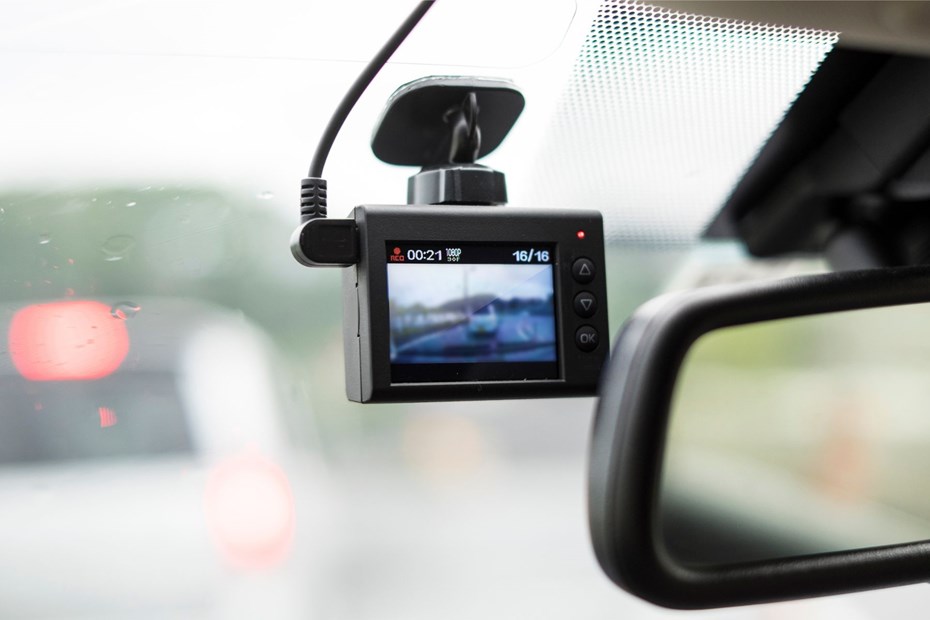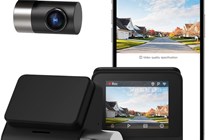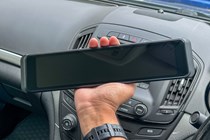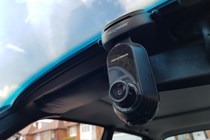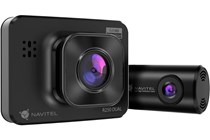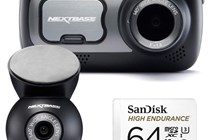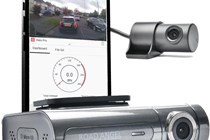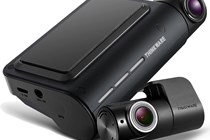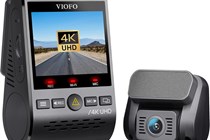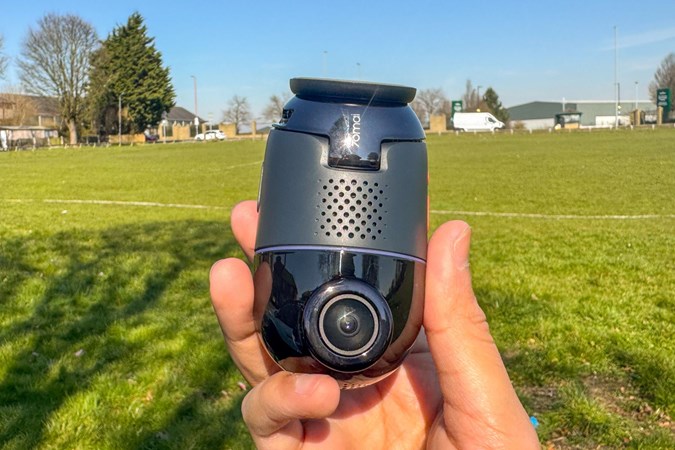If you’ve been browsing for the best dashcams available, you’ll have undoubtedly come across dual dashcams. These dashcams come in two pieces connected by a big cable and could be the ticket to the ultimate driving peace of mind.
Front-facing dashcams are all very well. They are good value and do the job for most people. They record situations in front of you, and that’s where most accidents are viewed more clearly.
Dashcams that record both the forwards and rearwards are called dual dashcams. A lot of them are high-performance units that will allow you to capture incidents that happen in front of and behind your car. And, given that rear-end collisions are the most common type of road accident, it pays to keep a watchful eye on what’s going on behind you.
The best dual dashcams 2025 at a glance
There are lots of options out there (including novel-looking mirror dashcams), so to help simplify your search, Parkers has rounded up the best dual dashcams around. Read on to find out which should make the top of your list.
How we test dual dashcams
We’re no stranger to testing dashcams here at Parkers, and we’re proud to conduct in-depth testing on products in their natural environment. All dual dashcams are tested as they are sold, which takes into account the accessories that are sold with each unit.
Each dashcam is fitted to a car and assessed over the course of a few weeks. This allows enough time to monitor the footage quality over a variety of situations; including low-light environments, rainy weather, and faster roads like the motorway. We look out for footage quality, build quality, installation, and ease of use. Finally, we consider the price of the unit when completing our test.
The best dual dashcams UK 2025
The best dual dashcam
I found it easy to install and it even comes with a 64GB memory card, so I was able to simply mount it, plug it in, and immediately start capturing footage. The app is also easy to connect to so you can download files straight to your phone.
The front camera has a 140° viewing angle so it can capture a wide view, while the rear camera has a 112° viewing angle. I am particularly impressed by the footage quality, especially in low light situations where the headlights of other cars didn’t dazzle the video footage too much.

Like the Viofo, the cable that connects the rear camera to the front is thick and strong, to avoid it getting damaged as easily as the power cable. The build quality is great, but I would say the Viofo has a slight edge in this aspect.
With its 4K recording ability, and its brilliant low-light performance, I think the Miofive S1 Ultra competes with some of the pricier dual dashcams. For the price, we’re struggling to find a better dashcam.
Review by Naveed Hussain
Pros
- Dual 4K resolution means clear video footage
- Great value for money for the specs
- Brilliant low-light footage quality
Cons
- Voice alerts might not appeal to everyone
Editor's pick
My experience with the chunky unit was great. It isn’t built like a traditional dashcam that is mounted using an arm, which means the entire front unit can be attached to the windscreen without interrupting much of the view.
Regarding build-quality; the cable that connects the rear camera to the front unit is rather thick. This means it’s stronger than other cables that I’ve tested, which is great for longevity, but a little tricker to install.

I quite like the video footage, which is rather quite smooth thanks to 60fps, but I found the low-light footage to be a little too dark for my liking. I get the impression that most of the features of this camera have been included thanks to its ability to shoot in 4K 60fps. The ability to support up to 512GB memory cards, connect to up to 4TB external storage, and Wi-Fi 6 technology, all means that larger video files can be downloaded as easily as smaller files from other dashcams.
The Viofo A329 is a wonderful unit that comes with a lot of bells, and many whistles, so if you want ultimate all-round coverage, then this dual dashcam will be all you need.
Review by Naveed Hussain
Pros
- Superior 60fps video quality
- Great build quality components including cable
- Can support larger storage solutions
Cons
- Low-light footage isn't as strong as other cameras
Best for ADAS
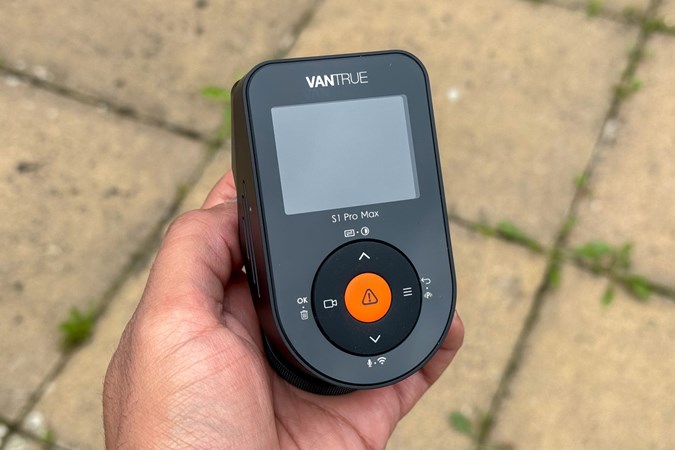

Having only been released in July 2025, the S1 Pro Max comes with Vantrue intelligence and an auto calibration function. This is hugely convenient when installing the camera as I didn’t need to worry too much about the direction in which it faces. The setup process is made even easier thanks to the fact that I didn’t even need to create an account to use the app.
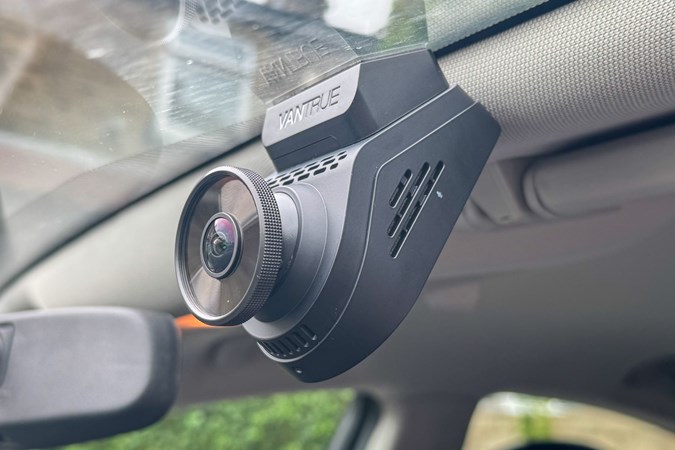
The footage is great, but I did find the contrast to be a little unfavourable. That being said, the low-light footage is great, so no issues there. 155° viewing angle on both cameras is brilliant to get a nice wide view of the road ahead and behind.
The S1 Pro Max comes with Vantrue intelligence, so ADAS features come as standards. Features like lane departure warning and the distance between you and the car ahead are useful, but the voice alerts are a little frequent.
Overall, the Vantrue S1 Pro Max is a brilliant camera filled with an array of useful features that are ideal for video capture. Let the dashcam do all the vital recording while you go about the business of driving.
Review by Naveed Hussain
Pros
- Dual 4K footage means consistent footage out of the front and rear
- Advance Driver Assistance Sytems come as standard
- Easy to set up with an easy to use app
Cons
- Footage contrast can be a little better
- Voice alerts are a little too frequent
The best for versatility
Fitting the dashcam isn’t any more difficult than other dual dashcams, and since there is a set of electrostatic stickers included it means my car’s windscreen was protected. I also found the crowbar to be of better quality than ones provided with other cameras.
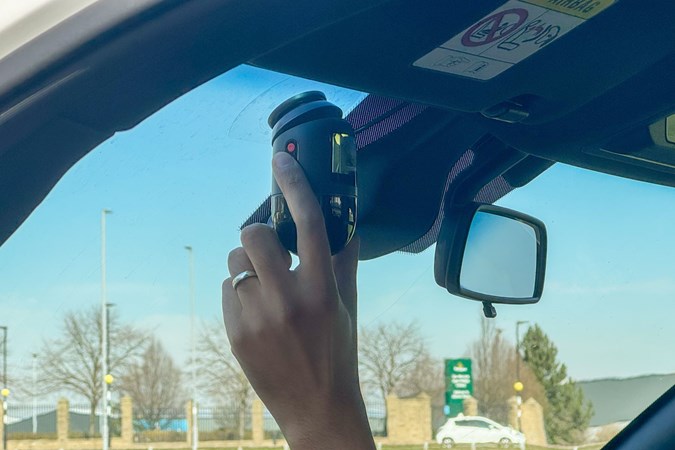
Footage quality is important, and the 4K Omni delivers. It can shoot 4K from the front camera and 1080p from the rear. Both cameras come with a Sony Starvis 2 sensor and HDR to ensure clear and stable footage. The front camera has a seven-layer lens which not only means I saw clear, well-balanced footage, but low-light footage was also great.
I didn’t have much use for the rotating lens, but I believe the 4K Omni is a lovely dashcam that can offer a little bit more than an ordinary dual dashcam. Think of it as a hybrid between two and three channel dashcams.
Review by Naveed Hussain
Pros
- Solid build quality that'll be reliable through bumps and bangs
- Great quality video footage with lovely contrast
- Intuitive to use, including the app
Cons
- Priced considerably higher than others
- Rotating function wasn't as useful to me as I imagined it would be
Best mirror dashcam
Installing the Mirror 1 is a bit tricker than other dashcams, especially since the rear camera is to be fitted to the exterior of the car. There's also the separate GPS antenna to deal with, but I have to mention that the GPS is one of the most accurate I've ever seen. It's great at notifying me of upcoming cameras, and accurately informed me the moment I passed them.
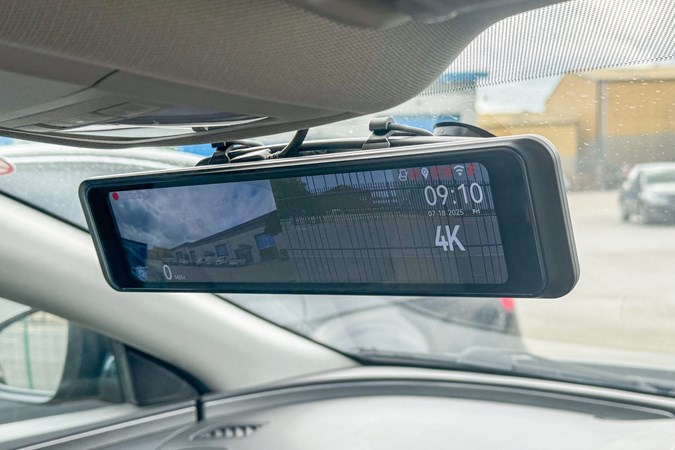
The voice alerts can be a little annoying, but I was able to easily turn the volume down. I didn't turn the volume completely off because I found the different functions rather useful, especially when the camera alerts you that the car ahead is moving away.
The rear camera was the only part that could have been improved, as the instructions mention to mount it as close to the reg plate as possible. This meant that rear visibility isn't exactly the same as it would be from a rear-view mirror, but there's no harm in mounting the camera a little higher. It's certainly ideal for cars without rear windscreen wipers or compromised rear visibility. The rear camera also shakes when going over bumps, but it always goes back to the position that I set, so I would say it is only somewhat steady during a bumpy ride.
Overall, I couldn't fault the footage quality and the display screen. Usability is great, and I love that there's several different ways that I could fit the mirror dashcam. If you're willing to go through the installation process then this camera will provide a rewarding experience in the end.
Review by Naveed Hussain
Pros
- Acts as a rear-view mirror as well as a camera
- GPS is accurate and voice alerts are genuinely useful
- Large 11.26-inch screen displays high-quality footage
Cons
- A little trickier to install than traditional dual dashcams
- Rear camera shakes when going over bumps
Best for interior recording
Then there's the size of the thing; it's bulkier than it looks in photos, and there's no way to use a 12V socket. Instead, you have to rely on the OBD2 port and hardwire the rest of it - it's properly hardcore.
The first thing that struck me is the speaker; it reminds me of a little Amazon Echo unit, only smaller. You can use it for voice control which only applies to the IQ. For instance, you can command it to save files, activate Witness Mode, as well as enabling Privacy Mode. Does it work? After clearing my throat and belting 'Hey dashcam, protect this file!' in my firmest Jon Bentley accent, it did so without fuss.
You can only do certain things with voice command though. Given that the IQ uses a large speaker for them, I can't help but think ridding it and putting a few buttons on the main unit would've been better.
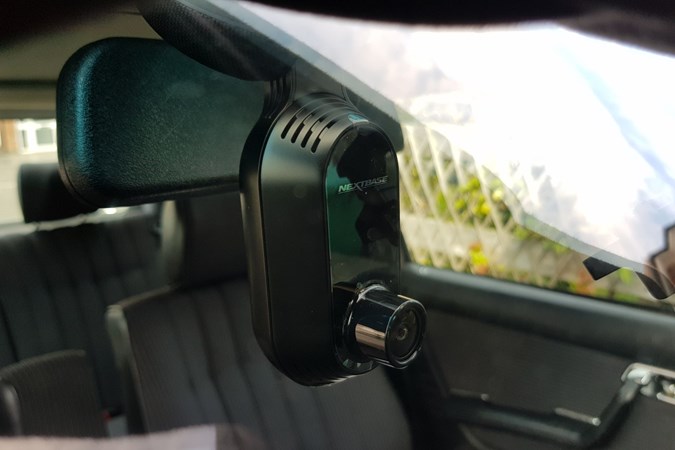
Setting it up is fairly straightforward, too. All you really need is the IQ app and a source of power, and you're good to go. You will have to hardwire the device in, and a professional installation comes in at approximately £80 from most fitters.
As for the recording quality, you can get a 1K, 2K, or 4K variant of the IQ, and I had the entry model on test. While at 1080P, it's able to record clearly enough for situations to be clearly seen, the picture is lacking behind other Nextbase products I've tried. For this price point, I'm not sure why one would opt for the 1K unit when you might as well spend a little extra to get the top package.
Additionally, I was staggered to learn that if you want to unlock the very best features, you have to get one of Nextbase's monthly subscriptions. If you don't after spending a mighty £350, you're stuck with the voice control feature itself and the app. You need either the Protect or Protect+ to unlock Witness Mode - which is one of the main appeals of the voice command in the first place.
The IQ isn't my sort of thing when it comes to dashcams. I'm a straightforward thinker who just wants everything in one place without fuss - and the 622GW does precisely that. If you're a hardcore dashcammer though, perhaps there's an IQ-spaced gap for you. But when you weigh up all the options, it's not recommendable enough for us.
Review by Aaron Hussain
Pros
- Slim design makes it convenient to mount onto the winscreen
- Setup is easy thanks to the intuitive design
- Voice alerts are useful
Cons
- Other dashcams offer better value and video resolution for the price
- Rear camera faces in the cabin and not out of the rear
The best simple dual dashcam
Like the 622GW, the 522GW still features voice-activated Alexa to essentially turn it into a smart device. In terms of video quality, it can record front and rear at either 1440p and 720p, respectively or 1080p for both. Thanks to clever software and a polarising filter, the image clarity and colour are excellent.
On top of the software, you get the best build quality of any dashcam, and it's a very easy device to use due to the three-inch touchscreen and simple menus.
Pros
- Good enough video quality, despite not being the best of the best
- GPS tracking included as well as Wi-Fi, Alexa, and G-Sensor
- Easy to use and comes with 64GB SD card
Cons
- Some may see the plethora of features as overkill
| <strong>Video quality (front/rear):</strong> | 1440p/720p, 1080p/1080p |
| <strong>Viewing angle (front/rear):</strong> | 140/140 |
| <strong>Frame rate:</strong> | 60fps or 30fps |
| <strong>Connectivity:</strong> | Wi-Fi, Bluetooth |
| <strong>GPS:</strong> | Yes |
| <strong>Memory card included:</strong> | Yes |
| <strong>Extras:</strong> | Alexa Built-in, Emergency SOS |
The most advanced dual dashcam
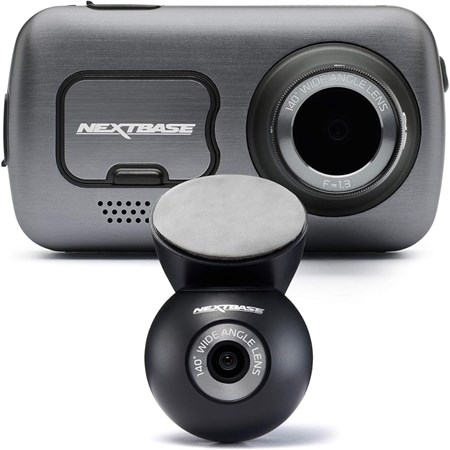

It also has a what3words setup built-in, which can send an exact location if you ever find yourself in an emergency. With a 140-degree viewing angle and exceptional night vision capabilities, it's one of the most comprehensive dual dashcams out there.
Pros
- Great quality unit, which you'd expect from a flagship model
- 4K recording resolution, making it one of the most capable out there
- Loads of features built-in from What3Words, Alexa, and GPS
Cons
- Features and overall package could be overkill for some
- Not a substantial difference over the 522GW in the grand scheme of things
Best value dual dashcam


I quite like value provided by the front camera, as the image is relatively clear in Full HD 1080p at 30fps. I did find there to be some blurry footage on faster roads, and low-light footage wasn't great. Oncoming traffic would dazzle the camera making it difficulty to shoot cleat footage. For the price, I think the front camera is a decent solution for your motoring needs, but it's a different story for the rear camera. At the rear you get a 140° field of view, and since Orskey doesn't say what the resolution of the rear camera is, I suspect it to be 720p. This isn't great, which means rear footage is quite blurry, and reg plates are hard to make out.
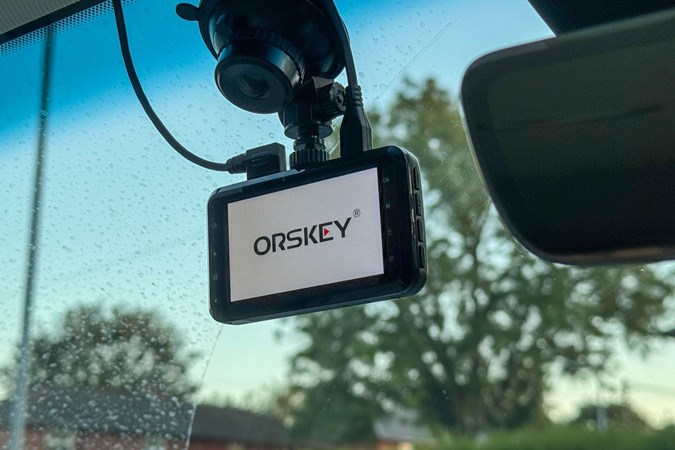
The S900 isn't packed with luxuries but instead focuses on delivering quality video. The Sony sensor combined with the HDR technology provides great image quality for this price bracket. The rear camera is waterproof and can be externally mounted above the rear number plate. I found this to be the best solution as it was difficult to mount internally, but do be aware that I found water droplets to sit on the lens after I washed my car rendering the rear camera useless.
While the video quality is a major plus point, so too is the ease of use. Many cheap dashcams fall down here and are a pain to use – but not the S900. As an affordable solution for tight budgets, the S900 is a great way to get coverage and peace of mind while on the road.
Review by Naveed Hussain
Pros
- Great value for money at under £40 for the whole bundle
- 1080p HD recording resolution is very impressive for the price point
- Useful features such as G-Sensor, parking monitor, and motion detection included
Cons
- The low price is reflected in the low-quality video from the rear dash cam
- Build quality and materials aren't as great as the others
| <strong>Video quality (front/rear):</strong> | 1080p/720p |
| <strong>Viewing angle (front/rear):</strong> | 170/140 |
| <strong>Frame rate:</strong> | 30fps |
| <strong>Connectivity:</strong> | No |
| <strong>GPS:</strong> | No |
| <strong>Memory card included:</strong> | Yes |
| <strong>Extras:</strong> | None |
The best budget dual dashcam
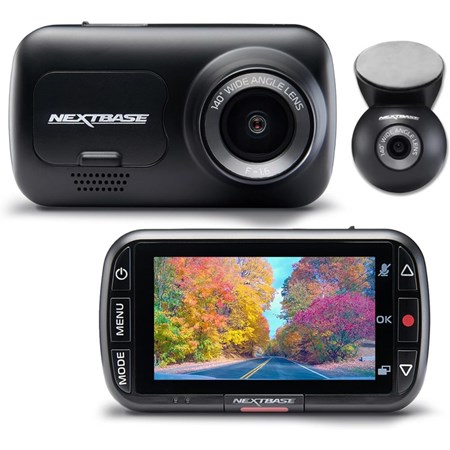

For starters, it still boasts a 1080p HD recording resolution which is still sharp enough to observe things clearly when watching back the footage. It also boasts a G-Sensor, a parking monitor, and a wide 140-degree viewing angle. For those who aren't fussed about having the most advanced features in a dashcam, this really ticks all the boxes.
Pros
- Great value for money at just £100 for a dual Nextbase setup
- Comes with a G-Sensor and parking monitor, which are useful dashcam features
- Relatively simple to use, which makes it a great setup for beginners
Cons
- 1080p HD recording resolution is sharp enough, but won't suit everybody
- Doesn't boast the best, most advanced features available
Best basic dual dashcam
The R250 records in Full HD 1080p at the front and HD 720p at the rear at 30fps. Its shape is compact, and while the two-inch touchscreen is not as good as the three-inch screen seen on the more expensive 522GW, it is perfectly useable.
Pros
- Compact design and shape, making it look quite subtle on the windscreen
- G-sensor included as well as parking mode and motion detection
- Great value for money at £75 for the full set
Cons
- Small touchscreen can make using it slightly trickier than others
| <strong>Video quality (front/rear):</strong> | 1080p/720p |
| <strong>Viewing angle (front/rear):</strong> | 140/100 |
| <strong>Frame rate:</strong> | 30fps |
| <strong>Connectivity:</strong> | No |
| <strong>GPS:</strong> | No |
| <strong>Memory card included:</strong> | No |
| <strong>Extras:</strong> | None |
FAQs and things to remember with dual dashcams
-
Is having a dashcam worth it?
There are plenty of good reasons to have a dashcam in the UK, even if it's a budget option. The most prominent is being able to identify what happened and who was at fault should something bad happen while driving.
This makes things easier for the insurance companies to determine, but footage of road-related events can also be useful to the police for submitting evidence. Having a dashcam is like having an eyewitness riding along with you at all times, and you can find yourself into many situations on the road, and a dashcam has got to be worth it on those grounds alone. -
Do dashcams bring down your insurance?
In some cases, having a dashcam setup can also help bring down your insurance premium. But this can depend on a number of factors that largely involve what insurance companies can offer. One good example is via dashcam manufacturer, Nextbase, which can reward its safe drivers.
It has actively partnered with a number of insurance companies, including AXA, Aviva, and others which are now offering insurance discounts to owners of Nextbase dashcams. However, this isn't the case for some insurers, and it's worth checking your policy and potential policies to see if you can be covered. -
What are important features in dual dash cams?
You'll see lots of features advertised by dashcam manufacturers, from in-built Wi-Fi to 4K resolution. For example, virtually all dashcams – even the cheapest – will feature a G-sensor to trigger automatic saving of footage if a bump is detected, loop recording to allow the camera to always capture new footage, and a parking monitor to let the camera capture incidents while the car is off and parked.
Front-facing cameras should be at least Full HD with a frame rate of 30fps for smooth, detailed video. High Dynamic Range (HDR) or Wide Dynamic Range (WDR) capability is a big plus. This reduces overexposure and helps produce a clear image. Take viewing angle into consideration, too, because the wider the angle, the more action the camera can capture; 140° should be a minimum.
Rear-facing cameras will usually have a lower resolution than the front camera, but 720p should still be your bottom line. Likewise, rear cameras may have a narrow viewing angle compared to the front-facing camera, but 100° should be a minimum here. Some rear cameras are externally mounted, though most are internal. All dashcams will require an SD card, so you should really check if the one you're buying has one included with your purchase.
Those are the essentials in front-and-rear-view dashcams. Extras such as Wi-Fi in dash cams and GPS are nice to haves; Wi-Fi gives you quicker access to files and settings, while GPS provides data on location and speed. The latter can be particularly beneficial in cases where you might want to prove that your speed wasn't a factor in whatever occurred. -
How should I install my dashcam?
While dash cams normally come with a 12V plug to insert into the cigarette lighter, you can opt for dashcam hardwiring kits. These are more fiddly to install but still not that difficult and will let you take advantage of the dash cam's parking monitor features because the dash cam will be wired directly to the car battery and powered when the car is switched off. Cables can be hidden in the interior headlining and other gaps, or you can just get your dashcam professionally fitted if you don't want to tackle the install.
Sign up to the Parkers Newsletter to keep up to date with more of the latest reviews, news, and recommendations from the Parkers team.
Just so you know, we may receive a commission or other compensation from the links on this website - read why you should trust us.


